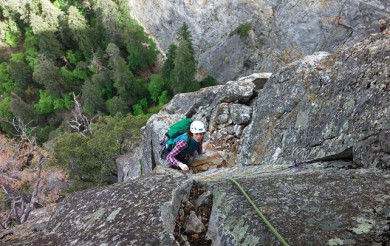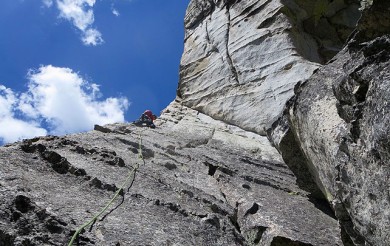A Route By Any Other Name
I have to admit, there’s a trend in climbing these days that is really getting under my skin. No, it’s not boomboxes at the cliff or permadraws, it’s referring to climbs by their grade instead of their name. Statements like “Want to do that 10c over there,” or “How’s that 12a?” Why can’t we just call a route by its name, or maybe describe it, like, did you check out the climb with that rad tufa pinch cross through sequence on it? But we are lazy, so we talk in grade speak.
Personally, I think this detracts from the experience for a couple of reasons. For one, route names are often creative expressions of the first ascentionist, and can be funny, descriptive, tell a story, etc. Bottom Feeder was a jab at the people coming to Rifle who didn’t put up routes. Down with Disease was put up while the developer dealt with a bout of Lyme disease. And so it goes. But I also think this trend reflects a deeper problem, that we are constantly measuring our progress by the grades we climb, which is a somewhat flawed system.
Gauging our progress in this manner would really only be useful if grades were universal, which they are not. Someone might be able to climb a 5.11 at one cliff, but only 5.10 at another, and maybe only 5.9 at yet another. A 5.8 climber at the Gunks, for example, would find themselves capable of many easy 5.10 sport routes in other places. Even indoors, where all factors are controllable, grades vary from facility to facility. Some intentionally sandbag, so it feels easier when you go outside. Others try to provide an accurate indoor portrayal of outside difficulty. Even in the one venue where grades could be universal, they are not, giving us little consistency outside of localized regions.
And then you add in the fact that routes are different for everyone. I’m tall and can reach the next jug easily, so it’s 5.8. My wife is short and there are no intermediates in between, so it’s solid 5.10. Or we’re at Indian Creek, where 5.10 for me is 5.11 for small hands, and 5.11 for me is 5.10 for those with small hands. Now, I’ll admit that grades are nice to give you a general idea of what to expect, but when you’ve been climbing awhile, you know generally what a certain level of climbing will feel like. For example, I know what 5.10 effort feels like, regardless of whether it’s called 5.10 or 5.8.
Also, I think there can be a lot of baggage attached to a grade. You know what you SHOULD be able to climb, so if it’s harder you might be really apprehensive about trying it, and if it’s easier and feels hard, you might be disappointed with your performance. When I lead climbing trips for a local high school, especially to a place like Indian Creek, we don’t tell them what they’ve been climbing on until the end of the trip. Some are surprised by how hard they climbed, others by how easy a route was they fell off. But in the end, they are free to enjoy the moment, without attaching any significance to a random and arbitrary grade.
This is how I would love to approach climbing, as unrealistic as it might be. Go out, find something that inspires me, and have at it, regardless of what the grade is. Do it for the fun of climbing, attempt to climb it in the best style that I can, as the grade is, in the end, not giving me anything compared to the movement and aesthetic beauty I’ll find waiting for me.
9 Responses to A Route By Any Other Name
Bulldog Creek Dog Walk (IV WI 4+)
Hayden Carpenter and Tom Bohanon recently repeated an obscure ice climb on the south side of Mt Sopris. Given a brief mention in Jack Robert’s ice guide, Bulldog Creek Walk is described as being 100 meters of WI 4. What they found was seven pitches of ice in a remote setting that makes for one […]
Connect with Us















I’m guilty of this, particularly at the gym. I’ll talk about a great 10 I just tried, or the new 9 that went up last week, etc. I’ve found this grade speak less prevalent outside; it’s hard to find routes without knowing their names. But agreed, we should give the first ascensionist/setter credit where credit is due, and learn a little more about our climbs!
Katie, I think we can let you off the hook in the gym, I mean how different is calling it the “blue route” from “that 10c”? 😉
BJ, your response to Katie kind of gives an answer to the question of this topic. The reason lots of people refer to routes by their grade instead of their names is because of the significance of the route. Obviously gym routes aren’t very significant so who cares what they’re named. On the other hand, you don’t hear very many climbers refering to a multi-pitch climb as “that 10a”. Then there’s the in between routes which are typically single pitch cragging types.
If you climbing at the Creek no one is calling Super Crack “some 5.10”, but the more obscure lower quality route near it may very well be called by its grade. Then there are the sport crags where there could be anywhere from a handful to hundreds of different routes of variying quality. The really high quality ones will probably be called by name but the rest that are just so so? Well if they didn’t catch your attention much when you climbed them then why would you put much effort into remembering what they’re called?
So basically I think, for most climbers if a route is really good and enjoyable to them they’ll probably remember the name, but if its not so great then they don’t really care. I know that applies to me anyway.
Steven, I think you’re spot on, and maybe I just tend to climb around folks that use the grades regardless of how good the route is. I think much of that probably stems from the fact that when we go out cragging, we know what grades we want to climb, so it’s just easier to refer to climbs by their numbers. I HAVE heard many a classic Creek routes called by their grade, kids these days have no respect!
Without question this is referring to single pitch cragging, I’ve probably never heard a multipitch route called by a grade.
BJ, just got back from the New River Gorge this weekend. After reading this article last week, I wanted to see if this occured at the NRG too. It sure does! Now that you mentioned it, it made it all that more annoying when people asked me, “Is anyone on that 10a?”. Bahhhh!! I made an effort to respond to everyone using the proper name of the climb. People doing this has always annoyed me. It gripes me in WW kayaking too. All too often you hear people spray about some “rad class IV run” instead of describing or naming the river. Hasn’t really hit me to pay attention to it and notice it until you wrote this.
Skiers should be so lucky, we have such creative names like “north trees” and “The east face”. Very rarely are ski routes named in a unique manner
Climbing route names are usually hilarious, and I wish ski routes were as creative.
Routes have to earn their names–they could earn that among the community, or just earn it with an individual … Once you hear people always refer to a route by its name, you’ll know it’s really great, or really scary, or even really bad. But it’s memorable in some way.
I’ve done lots and lots of routes, and I don’t always remember their names. Mostly, I’m guilty of not remembering what the warm-ups are called. But the ones that pierced me somehow–I’ll never forget their names.
nice post!
Not only climbers but magazines/news sometimes use grades when they talk about routes: ‘so and so climbed 15 a’ or what not…I understand that if Joe climbed a 5.10 is not impressive. It’s really sad that too many climbers are obsessed about grades and most of all difficult grades. We should not rock climb to show off how high our ‘grade is’ but enjoy a good route(or not if it didn’t fit our personal style or expectations) and learn from it(each route will teach you something enen if you don’t remember it).
The way I ‘judge’ a route is how it makes me feel during and after the climb. Generally a route ‘tells’ you how to move by the way the ‘moves’ are laid out. There are different ways to climb it but the easiest way is allways the same combination of moves. Some routes graded 5.10 are better then others graded 5.12 just because they felt right and it fit the way I like to climb. Even though ‘that 5.12’ wasn’t very hard to climb either.
Some people like cracks(Indian Creek), some like long reach moves or steep routes, roofs and so on…some people are tall or short, light or heavy, sad or happy, worried or calm…so grading is somewhat relative. It tells you it could be strenuous or not…but unfortunately too many times the grade is ‘the show off’ measure a lot of competitive climbers use. Rock climbing is a competition with your own self if we’re talking about competion.
Or sometimes you just don’t remember the name of the routes…and numbers(i.e. grades) are easier to remember especially if you agree with them. Grading applies to people as well: ‘yeah, that guy that climbs 5.15’s, I forgot his name’.
Climb on!
Most prevalent in sport climbing. Where there is a line of bolts every 6 feet, it genericizes the whole wall. Often you’re not climbing a wholly natural line… at a place like the Red you could climb just about anywhere on some walls, but your path is dictated by the bolts.
Add to that that sport climbing is often about the hard grades anyway, the consequence free gymnastic movement, and similarities to gym climbing.
I will cop to doing this while bouldering. How do you come up with a name for every 7 foot swath of rock anyway?
I say all that as a guy who likes to sport climb. I haven’t heard any climbs at indian creek referred to solely by grade however.